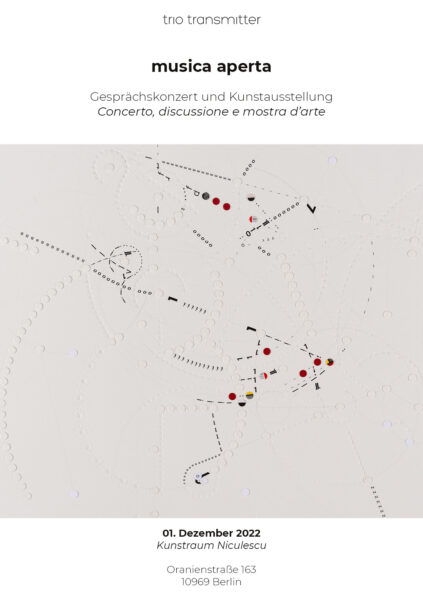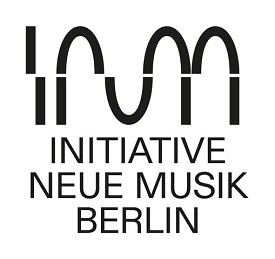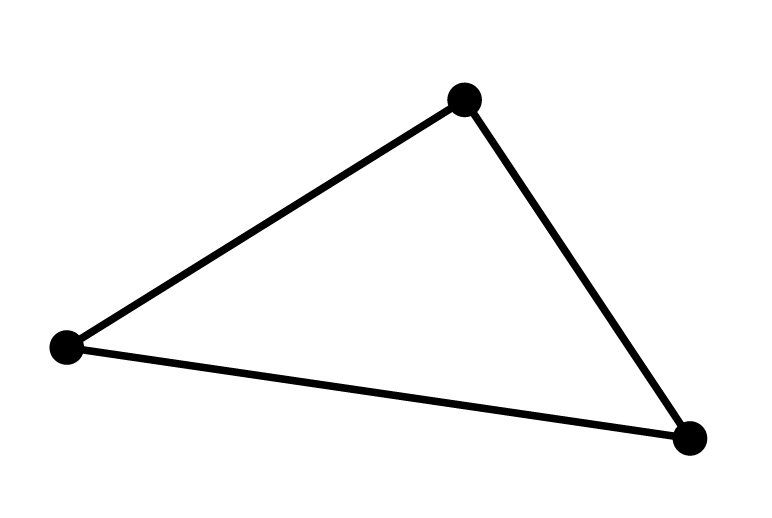graphical notation in music
Music theatre, visual graphics, pop music, sound art, spontaneous improvisation: musica aperta illuminates graphically notated music from a variety of perspectives. All six pieces were written for the ensemble by international composers and tell very personal and surprising musical stories.
Makiko Nishikaze trans-formed for trio (2022)
Florian Bergmann Capriccio (2022)
Christian Manuel Zanon lembi scabrosi (2022)
Hanna Hartman Apricots (2015)
Ignaz Schick Rof Oirt Rettimsnart (2022)
Benedikt Bindewald Neu gemischt (2022)
Florian Bergmann – clarinet, bass clarinet
Nikolaus Schlierf – viola, violin
Alba Gentili-Tedeschi – piano
Listening with the eyes?
Graphic notation offers musicians the possibility to imagine sound and action with their eyes. The notation is like a map that the ensemble can use to navigate together and create a space-sound situation. The composer accompanies this process to determine the final version.
The piece is notated in the form of a linear graphic score, which precisely determines the rhythm, while leaving pitches and timbres largely to the (spontaneous) decision of the performers. The basis is a cyclical groove inspired by experimental electronic dance music, which is sonically abstracted and transformed by the players. This results in a field of tension between the extremely different performance and reception practices of contemporary music on the one hand and beat-oriented music on the other, which is renegotiated with each performance of the piece.
Zanon makes no secret of his fascination with many aspects of musical technique, composition, the nature of sound and the importance of performance on stage. Even if they do not explicitly refer to music, the graphics and poetics of Zanon’s works – as well as his incessant thinking about the concept of time – nevertheless undoubtedly overlap with musical language and many of his works directly inspire a sonic translation.
Zanon’s works will be present in two forms: on the one hand as musical graphics translated into music, and on the other as a visual exhibition of the paintings and the sculptures linked to them.
Hanna Hartman – “Apricots”
“Alphabet – the apricot trees exist” is one of the inspirations for Hanna Hartman during the composition of the piece “Apricots” for the trio Transmitter. The composer works with very clearly defined, primarily static sounds that move in an extremely reduced frequency spectrum. The starting point is a special preparation of the piano, whose strings in the high and highest register are struck by jumping wooden apricots. Added to this are oven bricks rubbed together, which produce a fine, high-pitched clinking sound, the violin prepared with rocking metal rods and occasional toothed notes from the bass clarinet. The soundscape is complemented by some rather subliminal additions of water pattering on metal. Hartman’s graphic score organises the sound objects in such a way that a slowly unfolding, twice interrupted crescendo of intensity results.
In “Rof Oirt Rettimsnart”, Ignaz Schick provides each ensemble member with a total of 32 boxes containing more or less complex, graphically notated material. With a few exceptions, the performers can decide for themselves in which form and order they want to arrange them. The tonal material can be determined by the performers, while the duration, dynamics or pitch as well as the sequence of events in the individual boxes are precisely defined in the respective notation. Schick writes specifically for performers who, on the basis of their experience, can be considered as contributors or co-composers of the work. The structure is clearly laid down by the composer, but it is the performers who bring the material to life.
We are constantly being remixed. The algorithm reads us, shuffles our cards, and throws at our feet what it thinks it recognises in us. No one really knows where things are going any more, reality has been chopped up into too many small pieces to recognise any thread or logic in it. We dance “for reel” to the beat of some whistle. And yet there is our own path in life. Our own thread that guides us, even if we feel it is lost.

Musica aperta 2022 was supported by initiative neue musik berlin




